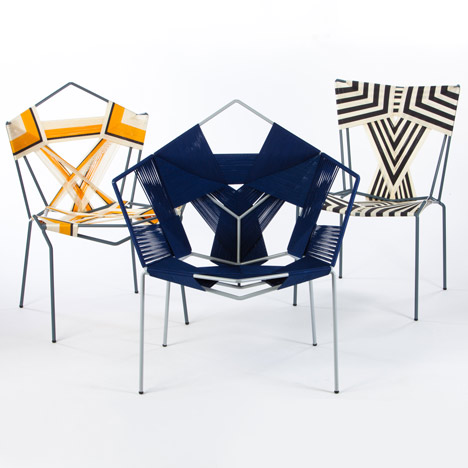Young designer Rami Tareef creates chairs with geometric patterns by wrapping and weaving cords around spare, steel frames.
The chairs are the product of Tareef’s COD Project (Crafts Oriented Design), in which the designer aims to update and preserve traditional weaving techniques.
He applies skills learned from a wicker craftsman in the Old City of Jerusalem to contemporary forms and materials.
The chairs are composed of only two materials; 500 meters of polypropylene cord are threaded around 10 meters of steel rod.
Alternating colours of cord create a secondary pattern in the weave that accentuates the chair’s structure.
Tareef is a recent graduate of Bezalel Academy of Arts and Design .
See all our stories on chairs »
Photographs are by Oded Antman.
Here's some more information from the designer:
The COD (crafts oriented design) project 2011
By Rami Tareef
What really happens in the encounter between craft and design, what fundamental differences in thought, planning and execution characterize the objects produced by the craftsman and the designer?
This past year I have been preoccupied by a fascinating endeavor that is, essentially, a hybridization of traditional craftsmanship and contemporary design. The project was born of my desire to create by embracing the truth of the material. A designer’s desire to explore, to engage in trial and error, to learn, to know and to produce something new − via the sole agency of his thinking hands.
The project tries to illuminate the differences and similarities between craft and design; it tests and stretches the limits of their hybridization, and tries to end up with something identifiable from that past world. The COD project deals with wicker/woven furniture − a traditional craft product − and preserves its production values while incorporating innovative design features from the world of mass production.
This One-Off stool try to make a new approach to the idea of "One of a kind" product by combination between traditional craft technique an high technology of cutting laser. It's came to raise question about status of products with hand made values in our saturated mass production world. Is there any soul in these products?
The rest (other 5 chairs) of the project deals in the hybridization between traditional craft technique and contemporary design attempt to create something new while keeping the truth of the old tradition.
Some chairs examine the technique and stretching the boundaries of it. The angular structure of the chair came up to keep the technique possible to apply.
On the other hand, part of the design trying to touch in textile design, it comes through the use of colors and multi-variable relationship between the cord and the chair structure that create many surfaces and three-dimensional spaces.
Further, the project came from my faith, as a young designer, that we should preserve traditional crafts by upgrade them through design and place them in the contemporary context in our world and culture.
I learned the basic technique from a wicker furniture craft man in the old city of Jerusalem and from there began a long development process that included dozens of models to upgrade technique.
Bezalel, Academy of art and design, Jerusalem – final project, B.Des of industrial design department
Furniture Craftsman: Abo Ahmad Nazir

